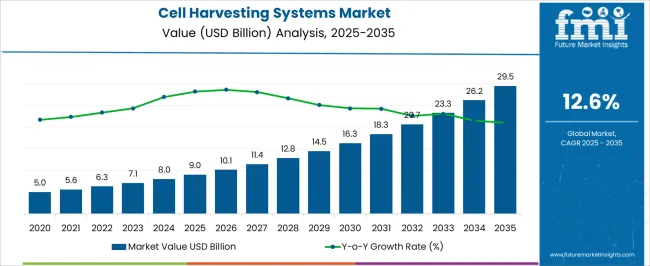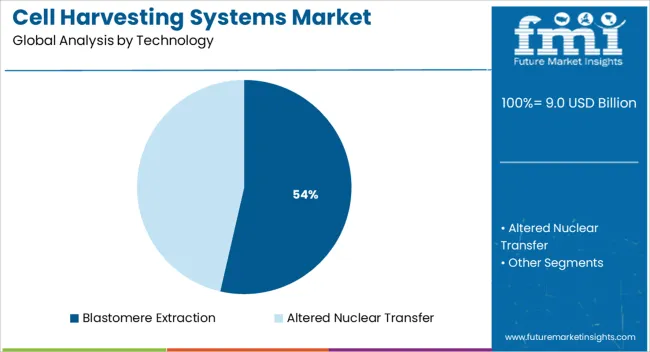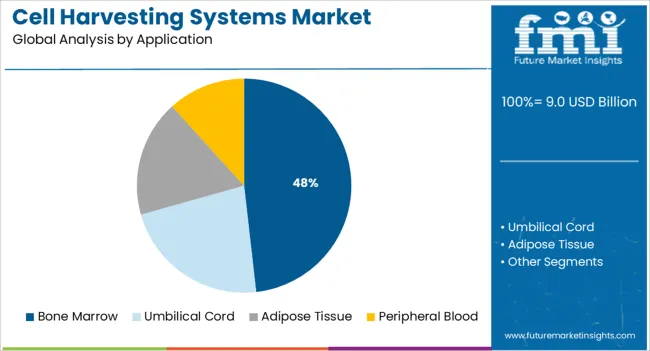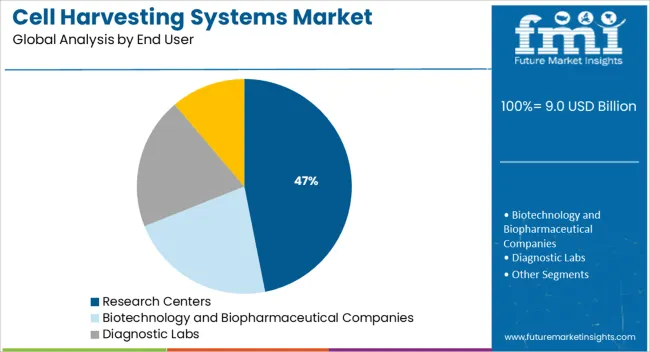The Cell Harvesting Systems Market is estimated to be valued at USD 9.0 billion in 2025 and is projected to reach USD 29.5 billion by 2035, registering a compound annual growth rate (CAGR) of 12.6% over the forecast period.

| Metric | Value |
|---|---|
| Cell Harvesting Systems Market Estimated Value in (2025 E) | USD 9.0 billion |
| Cell Harvesting Systems Market Forecast Value in (2035 F) | USD 29.5 billion |
| Forecast CAGR (2025 to 2035) | 12.6% |
The cell harvesting systems market is experiencing considerable growth driven by the expansion of regenerative medicine, increasing stem cell research, and advancements in personalized therapies. Rising demand for automated and precise cell extraction methods across clinical and research settings is influencing the widespread adoption of next generation harvesting technologies.
Innovations in device design and integration of real time monitoring systems have enhanced process efficiency and reduced contamination risks, improving yield and reliability. Government initiatives promoting stem cell banking and the surge in biopharmaceutical R and D have further amplified the demand for high quality cell separation and collection tools.
As the global healthcare landscape continues to prioritize individualized treatment approaches, the market for efficient and scalable cell harvesting solutions is expected to remain on an upward trajectory.
The market is segmented by Technology, Application, and End User and region. By Technology, the market is divided into Blastomere Extraction and Altered Nuclear Transfer. In terms of Application, the market is classified into Bone Marrow, Umbilical Cord, Adipose Tissue, and Peripheral Blood. Based on End User, the market is segmented into Research Centers, Biotechnology and Biopharmaceutical Companies, Diagnostic Labs, and Others. Regionally, the market is classified into North America, Latin America, Western Europe, Eastern Europe, Balkan & Baltic Countries, Russia & Belarus, Central Asia, East Asia, South Asia & Pacific, and the Middle East & Africa.

The blastomere extraction segment is anticipated to hold 53.60% of total market revenue by 2025 within the technology category, positioning it as the most dominant. This prominence is attributed to its precision in isolating viable cells at the embryonic stage, which is essential in applications involving preimplantation genetic diagnosis and developmental biology studies.
The technique ensures minimal disruption to embryo viability while offering high resolution cellular analysis, making it invaluable in advanced research protocols. The adoption of this method has been supported by technological improvements that allow for greater consistency and lower error margins during extraction.
With its strong alignment to reproductive health research and developmental studies, blastomere extraction remains the leading technology in the cell harvesting systems market.

The bone marrow segment is projected to contribute 48.20% of overall revenue by 2025 within the application category, reflecting its dominance in the market. This is due to its pivotal role in stem cell therapy, hematological treatments, and transplantation procedures.
Bone marrow remains one of the richest sources of stem cells, making it central to ongoing advancements in regenerative medicine. The increasing prevalence of blood cancers and immune disorders has driven the need for efficient bone marrow harvesting systems capable of preserving cell viability and maximizing therapeutic success.
Furthermore, improvements in minimally invasive extraction technologies have enhanced safety and patient outcomes. As the demand for stem cell therapies continues to expand, bone marrow is expected to retain its leadership as the primary source for cell harvesting applications.

The research centers segment is expected to represent 46.90% of the total market revenue by 2025 under the end user category, making it the leading segment. This growth is driven by the accelerating pace of cell based studies, tissue engineering research, and experimental therapies.
Research institutions require advanced and flexible harvesting systems to support high precision, reproducibility, and scalability in laboratory workflows. The rise in funding from public and private sectors for life sciences research has further bolstered the procurement of sophisticated cell harvesting equipment.
Additionally, research centers often serve as the initial point of innovation before clinical translation, making them critical users of emerging technologies. As scientific exploration intensifies in the fields of oncology, neurology, and regenerative medicine, research centers are expected to remain the core contributors to market expansion.
The major drivers of market expansion for cell harvesting systems are rising investments in regenerative medicine and cell-based research, expanding biotechnology and biopharmaceutical sectors, and rising prevalence of infectious and chronic diseases.
Due to urbanization, sedentary lifestyles, changing diets, rising obesity rates, and widespread access to tobacco products, cancer, and heart disease are now the leading causes of death in developing economies. The primary driver of market expansion is the potential application of stem cells in the treatment of numerous chronic diseases. Therefore, it is anticipated that the incidence of chronic and infectious disorders will drive the cell harvesting systems market expansion.
The market for cell harvesting systems is anticipated to grow significantly as bone marrow transplant procedures become more prevalent due to rising rates of anemia and blood cancer. In addition, increased healthcare spending per capita, post-therapy survival, logistical facility investment, expansion of the cardiac bone marrow transplant registry, and neurological ailments are all important factors.
The cell harvesting systems market is broadly divided into seven major regions, North America, Latin America, Europe, East Asia, South Asia, Oceania, and the Middle East and Africa.
North America is the leading region in the global cell harvesting systems market due to increased study spending and public projects, frequent use of stem cells for the treatment of cancer patients, and increased healthcare spending.
Apart from North America, the European cell harvesting systems market is also expected to display lucrative growth in the projected years due growing geriatric population and the presence of major players in the industry.
The East Asian region is predicted to show lucrative growth owing to the growing rates of cardiovascular diseases coupled with the rising geriatric population.
Sartorius AG, Danaher Corporation, Cox Scientific Ltd., Thomas Scientific, Teleflex Inc, Argos Technologies Inc, Perkin Elmer Inc, Arthrex Inc., Avita Medical, Tomtec, erumo Corporation, and Bertin.
| Report Attributes | Details |
|---|---|
| Growth Rate | CAGR of 12.6% 2025 to 2035 |
| Base Year for Estimation | 2024 |
| Historical Data | 2012 to 2024 |
| Forecast Period | 2025 to 2035 |
| Qualitative Units | Revenue in USD Billion, Volume in Units, and CAGR from 2025 to 2035 |
| Report Coverage | Revenue Forecast, Volume Forecast, Company Ranking, Competitive Landscape, Growth Factors, Trends, and Pricing Analysis |
| Segment Covered | Technology, Application, End User, Region |
| Region Covered | North America; Latin America; Europe; East Asia; South Asia; Oceania; Middle East & Africa |
| Key Countries Profiled | USA, Canada, Brazil, Mexico, Germany, UK, France, Spain, Italy, China, Japan, South Korea, Malaysia, Singapore, Australia, New Zealand, GCC, South Africa, Israel |
| Key Players | Sartorius AG; Danaher Corporation; Cox Scientific Ltd.; Thomas Scientific; Teleflex Inc; Argos Technologies Inc; Perkin Elmer Inc; Arthrex Inc.; Avita Medical; Tomtec; Terumo Corporation; Bertin |
| Customization | Available Upon Request |
The global cell harvesting systems market is estimated to be valued at USD 9.0 billion in 2025.
The market size for the cell harvesting systems market is projected to reach USD 29.5 billion by 2035.
The cell harvesting systems market is expected to grow at a 12.6% CAGR between 2025 and 2035.
The key product types in cell harvesting systems market are blastomere extraction and altered nuclear transfer.
In terms of application, bone marrow segment to command 48.2% share in the cell harvesting systems market in 2025.






Full Research Suite comprises of:
Market outlook & trends analysis
Interviews & case studies
Strategic recommendations
Vendor profiles & capabilities analysis
5-year forecasts
8 regions and 60+ country-level data splits
Market segment data splits
12 months of continuous data updates
DELIVERED AS:
PDF EXCEL ONLINE
Cellulose Diacetate Film Market Size and Share Forecast Outlook 2025 to 2035
Cellulose Fiber Market Forecast and Outlook 2025 to 2035
Cellulite Treatment Market Size and Share Forecast Outlook 2025 to 2035
Cellulose Derivative Market Size and Share Forecast Outlook 2025 to 2035
Cellulose Film Packaging Market Size and Share Forecast Outlook 2025 to 2035
Cellular IoT Market Size and Share Forecast Outlook 2025 to 2035
Cell Isolation Market Size and Share Forecast Outlook 2025 to 2035
Cellulose Ether and Derivatives Market Size and Share Forecast Outlook 2025 to 2035
Cellular Push-to-talk Market Size and Share Forecast Outlook 2025 to 2035
Cell Culture Waste Aspirator Market Size and Share Forecast Outlook 2025 to 2035
Cell Culture Media Market Size and Share Forecast Outlook 2025 to 2035
Cellulosic Polymers Market Size and Share Forecast Outlook 2025 to 2035
Cellbag Bioreactor Chambers Market Size and Share Forecast Outlook 2025 to 2035
Cell Surface Markers Detection Market Size and Share Forecast Outlook 2025 to 2035
Cellular Modem Market Size and Share Forecast Outlook 2025 to 2035
Cellulite Reduction Treatments Market Size and Share Forecast Outlook 2025 to 2035
Cell Culture Supplements Market Size and Share Forecast Outlook 2025 to 2035
Cell Culture Media & Cell Lines Market Size and Share Forecast Outlook 2025 to 2035
Cell Separation Market Size and Share Forecast Outlook 2025 to 2035
Cell Freezing Media Market Size and Share Forecast Outlook 2025 to 2035

Thank you!
You will receive an email from our Business Development Manager. Please be sure to check your SPAM/JUNK folder too.
Chat With
MaRIA